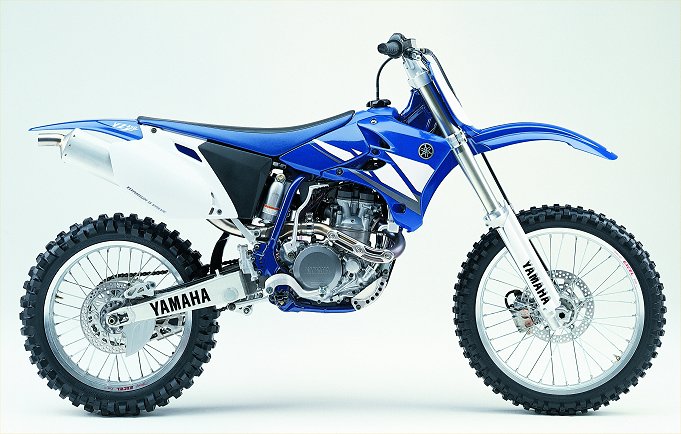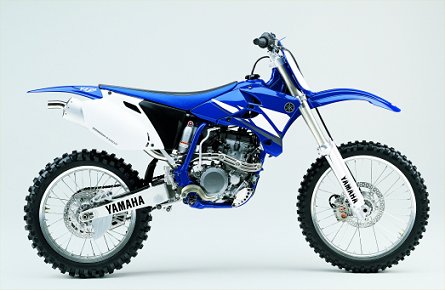
Yamaha’s 2003 YZ450F
Pictured above is the 2003 YZ450F motocrosser introduced today by Yamaha. Perhaps, the most highly anticipated off-road bike for 2003, the 450F represents Yamaha’s response to the challenge presented by Honda’s aluminum-framed CRF450R. The CRF450R set a new standard for light weight in the big-bore, four-stroke motocross category, but Yamaha claims the big YZ450F is one pound lighter (measuring wet weight of both machines — all fluids, except fuel). Amazing, given the fact that Yamaha has stuck with a chromoly steel frame.
Yamaha’s stated goals for the 450F include, ultimately, the “most competitive MX250 class bike” featuring light weight, quick reving motocross-type power, quick handling, and easy starting. The easy starting part is addressed, according to Yamaha, by an automatic decompression system, which allows easy kick starting. Essentially, the engine has extremely low compression below 1300 rpm (which is below the idle setting at 1800 rpm), allowing the kick starter to be utilized with minimal effort. Another big change is the four-speed transmission (compared to last year’s five-speed). It is no secret that many big-bore motocross bikes employ three-speed transmissions, so the four-speed tranny should not pose any issues for motocross racers. It could pose an issue regarding the versatility of the bike for use by off-roaders, however, but Yamaha’s new WR should address their needs, as well (see discussion below of the new WR line).
 |
|
Yamaha’s 2003 YZ250F
|
Overall, the 450F is a claimed 13 pounds lighter than last year’s 426F. Yamaha also claims that the 450F weights 232 wet, with no fuel (compared to 233 pounds for the CRF450R).
The 450F, and the redesigned YZ250F (6.6 pounds lighter than last year’s 250F) feature many other engine and chassis changes — changes that we will detail when we review each of these bikes later on. The 250F, already quite light for a 250 four-stroke machine, went through an extensive overhaul to maintain a competitive edge in light of anticipated competition from Honda, KTM and others in the 250 four-stroke motocross class. The 250F also has the automatic decompression system for easier kick starting, and the slim, low profile of the 450F (note the smaller, lower gas tank, flatter seat, etc.). Both bikes also feature a dramatic reduction in oil volume and weight associated with the oil circulation system.
Yamaha’s successful, off-road WR line also features dramatic changes, with electric start at the top of the list for both the WR450F and the WR250F. Difficult starting might have been the number one complaint by WR owners in years past, and the electric start system will obviously change that for the better. Another complaint concerned the bulbous off-road fuel tank on prior WR models, which offered large fuel capacity but impeded movement of riders on the machines. Frequently, WR seats and gas tanks were replaced by YZ-type items (flatter and smaller). For 2003, both WRs received dramatically improved ergonomics.





